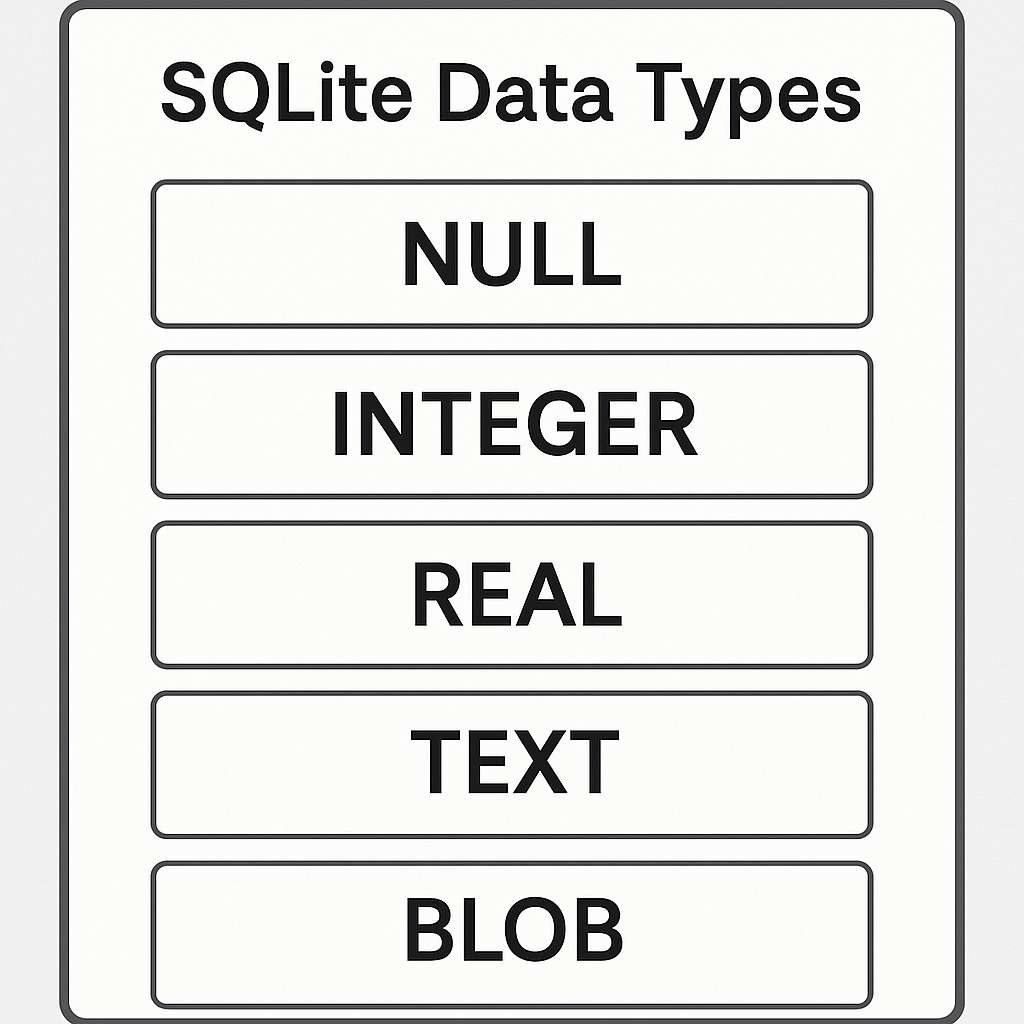Course
SQLite uses a flexible type system based on storage classes and type affinity. Unlike traditional RDBMSs that enforce strict typing, SQLite allows more dynamic type handling. Understanding this model is important for ensuring data consistency and avoiding subtle bugs in application logic.
In this article, I will explore the SQLite type system and show you how to work with common data types in SQLite. If you are new to SQL, consider starting with our Introduction to SQL course to build a strong foundation. Also, I find the SQL Basics Cheat Sheet, which you can download, is a helpful reference because it has all the most common SQL functions.
Core Concepts of SQLite’s Type System
To work with SQLite, it is important to grasp how it stores and interprets data internally. I will explain below how a SQLite-type system designs reliable and efficient applications.
Storage classes explained
SQLite uses five storage classes to represent values internally:
-
NULLrepresents a missing or undefined value. -
INTEGERrepresents a signed integer stored in 1 to 8 bytes, depending on the magnitude. -
REALdescribes a floating-point number stored as an 8-byte IEEE-754 value. -
TEXTstores text strings encoded in UTF-8, UTF-16BE, or UTF-16LE. -
BLOBstores binary data exactly as input, without any transformation.

SQLite Data Types. Image Source: OpenAI
These storage classes differ from the declared data types in a table schema. A column may be declared as VARCHAR(50) or BOOLEAN, but the actual value is stored using one of the five storage classes based on its content. This separation gives SQLite its dynamic and forgiving nature, but it also requires developers to be mindful of data validation and type consistency in their application code.
Type affinity and column behavior
Type affinity in SQLite is a recommended type assigned to a column based on its declared data type. SQLite uses the following rules to determine affinity from the declared type’s text.
-
Columns declared as
VARCHAR,CHAR, orTEXTgetTEXTaffinity. -
Types like
INTandINTEGERgetINTEGERaffinity. -
Declarations like
DECIMAL,NUMERIC, orBOOLEANgetNUMERICaffinity. -
Types like
REAL,FLOAT, orDOUBLEgetREALaffinity. -
The affinity defaults to
BLOBif no recognized type is declared.
For example, a column declared as VARCHAR(100) will have TEXT affinity, meaning SQLite will try to convert values to text when stored. This affinity guides how SQLite coerces and stores data, but does not restrict storing other types in that column.
Manifest typing and its implications
SQLite uses manifest typing, meaning the data type is associated with the individual value, not the column container. This allows multiple types of values to coexist in a single column. For example, a column declared as INTEGER can hold TEXT or BLOB values.
Manifest typing allows developers to insert diverse data types without altering the schema. However, its trade-off is that it can lead to inconsistent data, unpredictable sorting, and more reliance on application logic to enforce type rules.
I recommend taking our Database Design course to learn database management including organizing data in different data types and managing databases.
Working with Common Data Types in SQLite
Now let us look at how to handle common data types in SQLite, such as text, numbers, booleans, dates, and binary data.
Text, numbers, and booleans
SQLite commonly used data declarations include TEXT, INTEGER, REAL, NUMERIC, and BOOLEAN, but stores values based on type affinity, not strict types. The following are use cases for each data type in a real-world schema.
-
TEXTstores strings, suitable for names, emails, URLs, and general textual data. -
INTEGERis ideal for whole numbers such as counts, IDs, and codes, offering efficient storage and sorting. -
REALstores floating-point numbers for measurements, currency, or non-integer values. -
The
NUMERICaffinity covers values declared asDECIMAL,BOOLEAN, or similar. Depending on the value, SQLite attempts to store these asINTEGERorREAL. -
BOOLEANis not a native storage class but is simulated by storing0(FALSE) or1(TRUE) asINTEGERvalues behind the scenes.
I recommend using INTEGER for booleans with explicit application-side constraints, while NUMERIC is appropriate for values requiring flexible number parsing.
Dates, times, and temporal strategies
SQLite does not have a native DATE or DATETIME type, but supports the following formats for storing temporal data:
-
TEXT: Stores dates/times as ISO8601 strings likeYYYY-MM-DD HH:MM:SS. This format is human-readable and compatible with many tools, but can be slower for comparisons. -
REAL: Stores dates as Julian day numbers (floating-point), useful for date arithmetic and range queries, but less readable. -
INTEGER: Stores Unix timestamps, seconds since 1970-01-01. It is efficient for storage and fast numeric comparisons, but not human-readable.
When working with temporal data, you can use these functions: date(), time(), datetime(), julianday(), and strftime() for parsing, formatting, and converting between temporal formats.
Binary and numeric edge cases
SQLite also supports binary data via the BLOB storage class. BLOBs are useful for storing images, files, or any non-textual data. When working with BLOB data types, always use parameterized queries or bindings to insert BLOBs. You can also store large binaries externally and reference them with paths or hashes.
While SQLite can store integers up to 8 bytes (-2^63 to 2^63-1), values beyond this range may be silently converted to REAL data type. This may make the values lose precision. SQLite lacks strict enforcement for decimal precision, so always use external libraries or application logic for financial data when you need precision.
Enforcing structure with STRICT tables
Unlike the traditional flexible typing system, SQLite introduced STRICT tables in version 3.37.0. A STRICT table provides a stricter typing mode that enforces exact type matching for column values. When you declare a table as STRICT, every value inserted must match the column’s declared type, and any mismatch results in an error.
The STRICT mode improves data consistency and validation. It also helps catch type-related errors early during development and makes SQLite's behavior more predictable, closer to traditional RDBMSs.
Before using STRICT as a developer, you should note that it is only available in SQLite 3.37.0 and above. Also, you cannot mix STRICT and manifest typing in the same table.
Performance and Design Considerations
SQLite has a flexible type system with performance implications. SQLite uses variable-length encoding for INTEGER and REAL values, meaning smaller numbers use fewer bytes. This helps minimize database size, especially for large datasets.
Type affinity also influences how values are stored and compared. Inconsistent types in a column can reduce the effectiveness of indexes, since SQLite may perform extra type conversions during lookups, slowing down queries.
Consider the following strategies to design efficient schemas and queries.
-
Define columns with clear and consistent affinities to minimize type coercion overhead.
-
Consider explicit casting in queries when type conversion is needed to ensure consistent behavior.
-
Use
INTEGERaffinity for numeric IDs and counters,REALfor floating-point data, andTEXTfor strings. -
Avoid mixing data types in the same column to prevent sorting and comparison quirks.
-
Normalize schemas to avoid redundant type coercion or data duplication.
-
Use
EXPLAIN QUERY PLANto analyze performance and fine-tune queries.
SQLite Data Type Examples with Schema Patterns
The following table schemas illustrate the thoughtful use of SQLite’s data types, type affinity, and constraints.
Users table with boolean simulation and constraints
In the example below:
-
is_activesimulates a boolean usingINTEGERwith aCHECKconstraint. -
TEXTdata type ensures consistency for string values whileINTEGERis for boolean-like logic.
-- Create users table with auto-incrementing rowid and enforce uniqueness
CREATE TABLE users (
id INTEGER PRIMARY KEY,
username TEXT NOT NULL UNIQUE,
email TEXT NOT NULL,
is_active INTEGER NOT NULL DEFAULT 1 CHECK (is_active IN (0, 1)) -- Simulates boolean
);Orders table using temporal data and numeric precision
In the query below, total uses NUMERIC for currency-like values to handle precision at the application level. order_date is stored as TEXT in ISO-8601 format, ensuring readability and compatibility with date functions.
-- Create orders table with row identifier and foreign key in practice
-- ISO date format "YYYY-MM-DD"
CREATE TABLE orders (
order_id INTEGER PRIMARY KEY,
customer_id INTEGER NOT NULL,
total NUMERIC NOT NULL,
order_date TEXT NOT NULL CHECK (length(order_date) = 10) );Files table with binary and type checks
In the query below, content uses BLOB to store raw binary data. uploaded_at stores time as an INTEGER for space and performance efficiency.
-- Create files table with raw binary data and Unix timestamp (epoch seconds)
CREATE TABLE files (
file_id INTEGER PRIMARY KEY,
name TEXT NOT NULL,
content BLOB NOT NULL,
uploaded_at INTEGER NOT NULL
);You can verify the type at runtime with the following query:
SELECT typeof(uploaded_at), typeof(content) FROM files;I recommend taking our Introduction to Relational Databases in SQL course to learn more about data structures and how to create tables in databases.
Comparing SQLite to Other Databases
SQLite’s type system is more flexible than traditional RDBMSs like MySQL or PostgreSQL. The table below compares SQLite to these databases.
|
Feature |
SQLite |
MySQL |
PostgreSQL |
|
Typing Model |
Dynamic (manifest typing, type affinity) |
Strict (with some quirks, like silent coercion) |
Strict (strong typing enforced) |
|
Declared Type Enforcement |
Not enforced (unless |
Mostly enforced, but allows some flexibility |
Fully enforced |
|
Boolean Handling |
Simulated like |
Has |
Native |
|
Date/Time Types |
Stored as |
Native date/time types |
Native and extensive temporal types |
|
Index Sensitivity |
Sensitive to mixed types in a column |
Reliable due to typing |
Reliable due to typing |
|
Schema Flexibility |
Very high (few constraints by default) |
Moderate |
Structured and robust |
|
Migration Into SQLite |
May need to relax strict type enforcement |
Generally smooth with minor adjustments |
May require simplification or loss of precision |
|
Migration From SQLite |
Requires data cleanup and typing normalization |
Needs data conformity to stricter typing |
Needs data conformity and stricter schema |
Conclusion
SQLite has a flexible typing system that offers different advantages when used thoughtfully. Developers can design schemas that balance adaptability with reliability by understanding storage classes, type affinity, and manifest typing. Features like STRICT tables, consistent type usage, and normalization help enforce structure where needed.
As a next step, I recommend taking our Exploratory Data Analysis in SQL and Data Manipulation in SQL courses to learn how to analyze data of different data types using advanced SQL queries.
FAQs
What are SQLite’s storage classes?
SQLite storage classes include NULL, INTEGER, REAL, TEXT, and BLOB.
Can a column store multiple data types?
Yes, unless the table is declared as STRICT, any column can hold values of different types.
What is type affinity in SQLite?
Type affinity is a recommended type for a column based on its declared type. SQLite tries to convert inserted values to the column’s affinity type, but does not strictly enforce it.
How are BOOLEAN values handled in SQLite?
SQLite does not have a separate BOOLEAN type. Boolean values are typically stored as INTEGER, 0 (FALSE) or 1 (TRUE), using NUMERIC affinity.
How can I check how a value is stored?
Use the typeof() function to inspect the actual storage class of a value.

